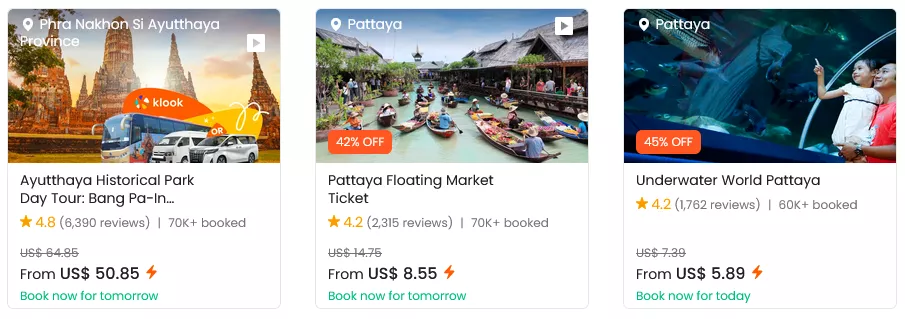
ℹ️ Useful Information
✈️ How to get there
🚍 Transport Options
☀️ Weather Forecast
🏡 Where to stay
🔍 Activities + Places
❓ FAQ + Travel Tips
🎫 Book a Tour Online
🎫 Book Tickets / Car
Thailand: Land of Diverse Landscapes and Cultural Charms:
Thailand, officially known as the Kingdom of Thailand, is a captivating country located in Southeast Asia. Renowned for its vibrant culture, stunning landscapes, and warm hospitality, Thailand has become a beloved destination for travelers from around the world. Let’s delve into the key aspects of Thailand’s location and geography.
-
- Geographical Location: Thailand is situated in the heart of Southeast Asia, bordered by Myanmar (Burma) to the west and northwest, Laos to the northeast, Cambodia to the southeast, and Malaysia to the south. Its long coastline stretches along the Gulf of Thailand to the east and the Andaman Sea to the west.
- Diverse Landscapes: The geography of Thailand is incredibly diverse, featuring a variety of landscapes that cater to different interests. From lush jungles and fertile plains to rugged mountains and pristine beaches, Thailand offers an array of natural wonders waiting to be explored.
- Central Plains and Chao Phraya River: The central region of Thailand is dominated by the vast, fertile plains of the Chao Phraya River, the country’s major waterway. The Chao Phraya River serves as a lifeline for Thailand, supporting agriculture and commerce while passing through the capital city, Bangkok.
- Northern Highlands and Hill Tribes: To the north, Thailand’s geography transforms into majestic highlands and mountain ranges. Here, travelers can explore lush forests, visit hill tribe villages, and experience a cooler climate compared to the central plains.
- Isaan Plateau: Northeastern Thailand is occupied by the Isaan Plateau, characterized by its arid landscapes and vast rice fields. This region offers a glimpse into traditional Thai rural life and is known for its unique cuisine.
- Southern Peninsula: The southern region of Thailand boasts a picturesque peninsula surrounded by the Gulf of Thailand and the Andaman Sea. This area is renowned for its idyllic islands, such as Phuket, Koh Samui, and Koh Phi Phi, drawing visitors with their pristine beaches and crystal-clear waters.
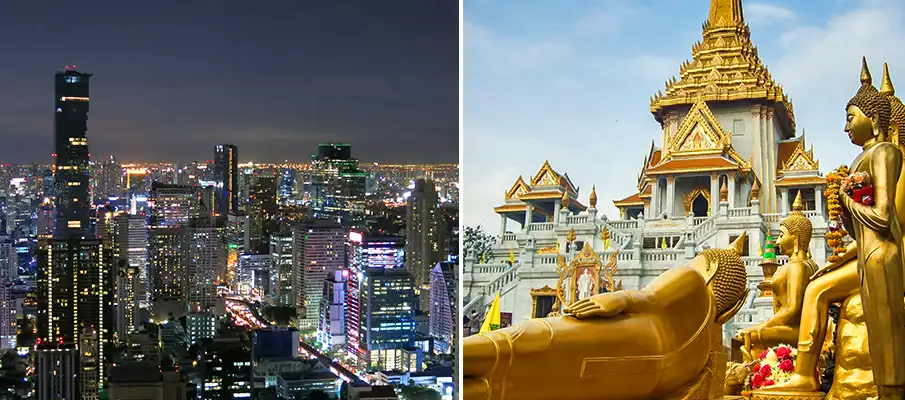
Thailand: A Fascinating Journey Through Time and Culture.
Thailand, formerly known as Siam, boasts a rich and fascinating history that spans over thousands of years. From ancient civilizations to modern nationhood, Thailand’s history weaves a tapestry of cultural evolution and dynastic rule. Let’s explore the key milestones that have shaped the captivating history of this Southeast Asian nation.
-
- 1. Ancient Kingdoms and Early Civilizations: Thailand’s history dates back to prehistoric times, with evidence of early settlements dating to around 4,000 BCE. Several ancient kingdoms, such as the Dvaravati and Khmer empires, flourished in different regions of present-day Thailand, leaving behind magnificent temples and artifacts.
- 2. The Rise of Sukhothai: In the 13th century, the Sukhothai Kingdom emerged as a powerful state under King Ramkhamhaeng, considered the founder of the Thai nation. Sukhothai’s golden era marked a period of cultural flourishing, and the Thai script was established during this time.
- 3. Ayutthaya: The Glorious Capital: The Ayutthaya Kingdom, founded in the 14th century, rose to prominence and became one of Southeast Asia’s most prosperous and influential capitals. Ayutthaya thrived as a cosmopolitan city, attracting traders and travelers from around the world. However, the kingdom fell to Burmese invaders in 1767, leading to the collapse of Ayutthaya’s empire.
- 4. The Chakri Dynasty and Modern Thailand: In 1782, General Chakri, known as King Rama I, established the Chakri Dynasty, which continues to rule Thailand to this day. Bangkok became the new capital, and the city’s Grand Palace stands as a testament to the dynasty’s enduring legacy. The Chakri monarchs played a pivotal role in modernizing Thailand and preserving its independence during the colonial era.
- 5. Thailand in the 20th Century: Thailand managed to maintain its sovereignty amid colonial pressures and emerged as a constitutional monarchy in the early 20th century. The country witnessed periods of political turbulence, but its resilience and dedication to preserving its culture remained unwavering.
- 6. Contemporary Thailand: In modern times, Thailand has experienced remarkable economic growth and development while maintaining its cultural heritage. Known for its warm hospitality and vibrant festivals, the country has become a popular destination for travelers worldwide.
BOOK a TOUR / ACTIVITY in Thailand ➜
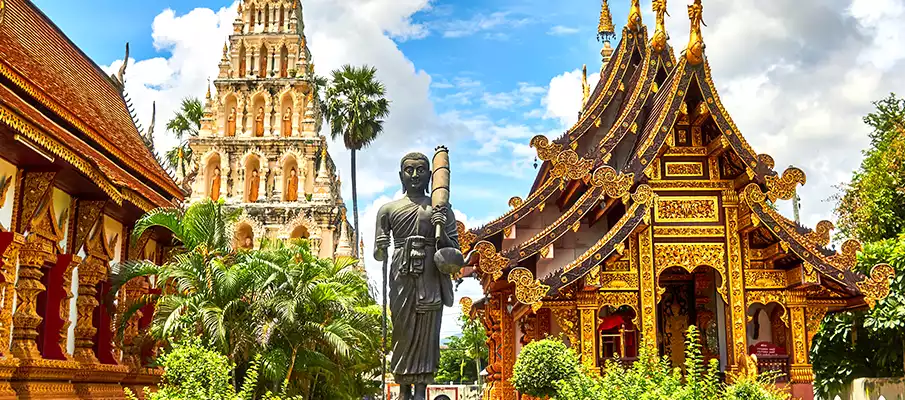
Culture and Festivals of Thailand: Embracing Tradition:
Thailand’s rich cultural heritage is a colorful tapestry that reflects the country’s diverse history and the harmonious coexistence of traditional customs and modern influences. Thai culture is characterized by its warm hospitality, respect for elders, and devotion to Buddhism. Throughout the year, Thailand comes alive with a myriad of vibrant festivals that celebrate religious beliefs, harvests, and cultural traditions. Let’s delve into the essence of Thai culture and some of its most significant festivals.
Thai Culture: A Tapestry of Traditions: Thai culture is deeply rooted in the teachings of Buddhism, which shapes the way of life for many Thais. The wai, a traditional gesture of greeting, is a display of respect and is commonly practiced when meeting others. The importance of family and community is evident in daily life, with the Thai people cherishing their close-knit relationships.
Festivals: A Kaleidoscope of Celebrations:
-
- 1. Songkran – Thai New Year (April 13-15): Songkran is one of Thailand’s most famous festivals, marking the traditional Thai New Year. Celebrated during the hottest month of the year, it involves water splashing and symbolic cleansing, signifying the washing away of bad luck and starting anew.
- 2. Loy Krathong (November): Loy Krathong, the Festival of Lights, is a mesmerizing celebration where people release beautifully decorated lotus-shaped baskets (krathongs) into rivers, lakes, and canals. The glowing krathongs carry away bad luck and symbolize a fresh start.
- 3. Yi Peng Lantern Festival (November): Yi Peng is a stunning spectacle where thousands of paper lanterns are released into the night sky, creating a breathtaking display of floating lights. This festival is most prominent in Chiang Mai.
- 4. Phi Ta Khon – Ghost Festival (June/July): This lively festival in the northeastern region of Thailand involves elaborate masks and colorful costumes, as locals dance and parade through the streets to honor spirits and bring good fortune.
- 5. Royal Ploughing Ceremony (May): This ancient Brahmanical rite, held in Bangkok, marks the beginning of the rice planting season. Members of the royal family participate in the ceremony, symbolically plowing the field to ensure a prosperous harvest.
- 6. Vegetarian Festival (October): Observed by Chinese communities in Thailand, this festival involves strict vegetarian diets and elaborate processions to purify the mind and body.
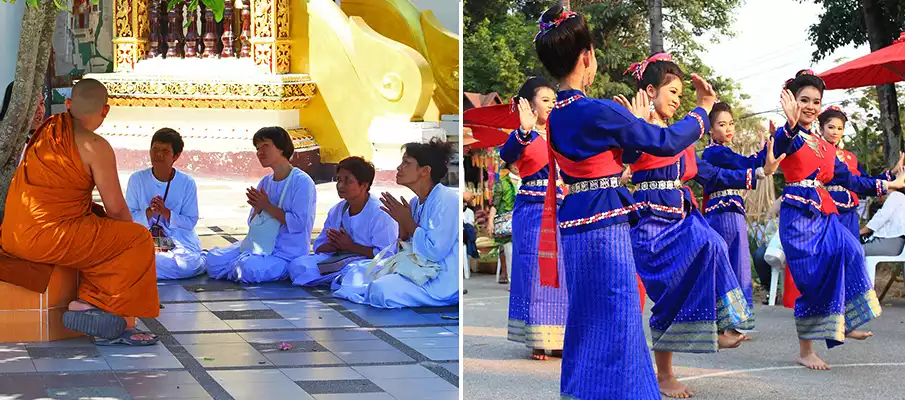
Religion in Thailand: Harmony Amid Diversity.
-
- Religion in Thailand: Thailand, a land of golden temples, stunning landscapes, and warm smiles, boasts a diverse and harmonious religious landscape that reflects the country’s rich cultural tapestry. Buddhism is the dominant faith, but Thailand’s spiritual spectrum encompasses a blend of indigenous traditions, Islam, Christianity, and more, creating a unique atmosphere of tolerance and coexistence.
-
- Theravada Buddhism: Thailand is often referred to as the „Land of the Free“ with Theravada Buddhism being the heart of its spiritual identity. This form of Buddhism permeates every facet of Thai life. Temples, with their intricate architecture and iconic spires, serve as both religious centers and cultural landmarks. Monks, or ‚bhikkhus,‘ play a significant role in guiding the faithful and preserving traditional customs. Thai people frequently engage in rituals like almsgiving, meditation, and temple visits, seeking spiritual enlightenment and merit.
-
- Indigenous Beliefs: Before Buddhism’s arrival, indigenous beliefs shaped the lives of Thailand’s people. These animist traditions continue to thrive alongside Buddhism, emphasizing a deep connection to nature and spirits residing in trees, rivers, and mountains. The worship of ancestral spirits is also an essential part of Thai culture, with offerings and ceremonies to honor and seek guidance from the departed.
-
- Religious Diversity: Thailand’s religious landscape is a harmonious blend of diverse faiths. A small but influential Muslim minority resides primarily in the southern provinces, while a significant Christian community, predominantly Catholic, has gained a following among various ethnic groups. These religious communities live side by side with Buddhists, promoting a peaceful coexistence that speaks to the nation’s commitment to religious tolerance and diversity.
-
- Unity in Diversity: Thailand’s government actively supports religious freedom and respects the practice of various faiths. The acceptance of diverse religious beliefs is a testament to the unity that thrives in Thai society. Whether through grand festivals, shared traditions, or daily acts of respect, Thailand’s religious harmony is a model of peaceful coexistence.
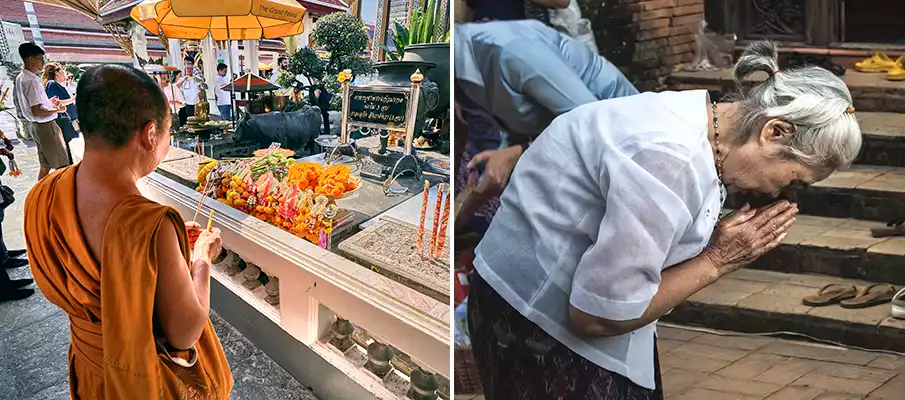
Economy of Thailand: A Thriving Southeast Asian Tiger.
Thailand, known for its stunning landscapes and vibrant culture, is also a thriving economic powerhouse in Southeast Asia. Over the years, the country has transformed itself from an agriculture-dependent nation to a diverse and export-oriented economy. Let’s explore the key aspects that contribute to the economic prowess of Thailand.
-
- 1. Strong Industrial and Service Sectors: Thailand boasts a robust industrial sector, with manufacturing and export-oriented industries playing a significant role in the economy. Automobiles, electronics, textiles, and food processing are among the leading manufacturing sectors. Additionally, the service sector, including tourism, banking, and retail, contributes significantly to the nation’s economic growth.
- 2. Exports and International Trade: Thailand is a major player in the global market, with exports being a key driver of its economy. The country exports a wide range of goods, including rice, electronics, automobiles, and processed food products. Its strategic location in the heart of Southeast Asia makes it a hub for international trade, fostering economic partnerships with neighboring countries and beyond.
- 3. Tourism: A Pillar of Growth: Thailand’s stunning landscapes, rich cultural heritage, and warm hospitality have made it one of the world’s most popular tourist destinations. Tourism is a vital pillar of the Thai economy, generating significant revenue and providing employment opportunities for millions of people.
- 4. Agriculture and Food Production: Although Thailand has diversified its economy, agriculture remains a significant sector, especially in rural areas. The country is a major producer and exporter of rice, rubber, and seafood products, contributing to its food security and international trade.
- 5. Government Initiatives and Investment: The Thai government has implemented various policies and initiatives to promote economic growth and attract foreign investment. Special economic zones and tax incentives for foreign investors have encouraged businesses to set up operations in Thailand.
- 6. Economic Challenges: Despite its economic successes, Thailand faces challenges such as income inequality, regional disparities, and fluctuations in global demand. The country’s ability to navigate these challenges while pursuing sustainable and inclusive growth will be crucial for its continued economic development.
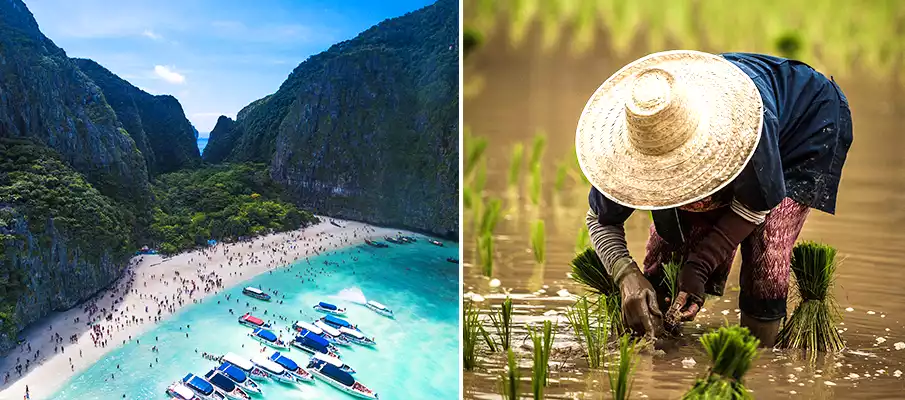
Tourism of Thailand: Unveiling the Enchanting Land of Smiles.
Thailand, often referred to as the „Land of Smiles“, has become a beloved destination for travelers worldwide. Renowned for its warm hospitality, stunning landscapes, and vibrant culture, Thailand offers an array of experiences that captivate the hearts of visitors. Let’s explore the allure of Thai tourism and the key factors that make it a top destination.
-
- A Diverse Tapestry of Experiences: Thailand’s tourism charm lies in its diverse offerings, catering to a wide range of interests. From bustling cities like Bangkok with their bustling markets and historical landmarks to serene islands with pristine beaches, each destination presents a unique experience for travelers.
- Cultural Treasures and Ancient Heritage: The rich cultural heritage of Thailand is showcased through its magnificent temples, such as Wat Pho and Wat Arun in Bangkok, and the historic city of Ayutthaya. Visitors can immerse themselves in traditional Thai dance, art, and rituals, experiencing the country’s spiritual essence.
- Breathtaking Natural Beauty: Thailand’s natural beauty leaves travelers in awe. The lush jungles of Chiang Mai, the emerald waters and beaches of Phuket, Krabi or Phi Phi Islands, and the majestic waterfalls of Erawan National Park are just a few examples of the country’s stunning landscapes waiting to be explored.
- Delectable Cuisine: Thai cuisine is a highlight of any trip to Thailand. From mouthwatering street food to sumptuous dishes served in restaurants, the flavors of Thai food are a delightful fusion of spicy, sweet, sour, and salty, pleasing the palates of food enthusiasts.
- Vibrant Festivals and Celebrations: Thailand’s calendar is filled with lively festivals that showcase the country’s rich traditions and religious customs. Songkran, Loy Krathong, and Yi Peng Lantern Festival are among the most celebrated events, offering visitors an opportunity to join in the merriment and experience Thai culture firsthand.
- Warm Hospitality: Thailand’s reputation for warm hospitality is well-deserved. The genuine friendliness and welcoming nature of the Thai people leave a lasting impression on travelers, creating an atmosphere of comfort and familiarity.
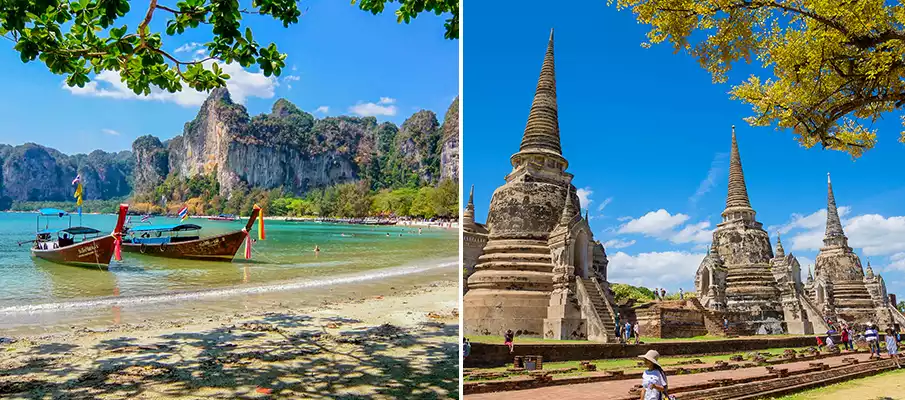
The biggest and frequented tourist cities in Thailand:
-
- Bangkok: As the capital and largest city of Thailand, Bangkok is a bustling metropolis that enthralls visitors with its dynamic blend of modernity and tradition. The city’s skyline is adorned with skyscrapers, while ancient temples like Wat Pho and the Grand Palace stand as architectural marvels. Explore vibrant markets, savor delectable street food, and experience the bustling nightlife that makes Bangkok a city that never sleeps.
- Phuket: Phuket is Thailand’s largest island and a popular beach paradise in the Andaman Sea. Boasting crystal-clear waters, palm-fringed beaches, and a vibrant atmosphere, Phuket draws travelers from around the globe. From water sports and island hopping to lively entertainment in Patong Beach, Phuket offers a perfect blend of relaxation and excitement.
- Chiang Mai: Nestled in northern Thailand, Chiang Mai is renowned for its serene beauty and cultural heritage. Surrounded by mountains, the city boasts ancient temples like Wat Phra Singh and Wat Chedi Luang. Visitors can partake in elephant sanctuaries, explore hill tribe villages, and indulge in traditional Lanna cuisine, immersing themselves in the charms of this cultural gem.
- Pattaya: Located on the Gulf of Thailand, Pattaya is a vibrant coastal city known for its lively entertainment and vibrant nightlife. Beyond the bustling Walking Street, Pattaya offers a range of water activities, family-friendly attractions like Cartoon Network Amazone Waterpark, and serene beaches for relaxation.
- Hua Hin: A favored destination for both locals and international travelers, Hua Hin is a charming coastal town south of Bangkok. The town’s tranquil atmosphere, historical sites like Hua Hin Railway Station, and pristine beaches make it an ideal retreat for relaxation and leisurely activities.
- Krabi: Nestled on the Andaman Coast, Krabi is a captivating province adorned with limestone cliffs, lush jungles, and pristine beaches. The stunning Railay Beach, accessible only by boat, is a paradise for rock climbers and beach lovers alike. Visitors can explore the Emerald Pool, hike to the Tiger Cave Temple, and take boat tours to nearby islands, such as Phi Phi and James Bond Island.
- Ayutthaya: Steeped in history, Ayutthaya is an ancient city located just north of Bangkok. Once the magnificent capital of the Ayutthaya Kingdom, it now stands as an archaeological treasure with well-preserved temple ruins and historical sites. Explore the Ayutthaya Historical Park, Wat Mahathat with its iconic Buddha head entwined in tree roots, and the impressive ruins of Wat Phra Si Sanphet, gaining insights into Thailand’s glorious past.
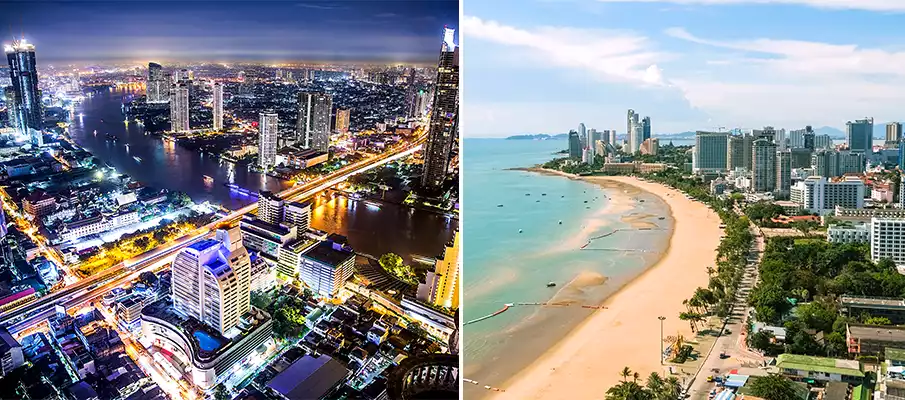
The Most Popular and Visited Tourist Sites in Thailand:
-
- 1. Grand Palace (Bangkok): The Grand Palace in Bangkok is a majestic complex that served as the official residence of the Thai monarchs for centuries. Visitors are awestruck by the intricate architecture, shimmering golden spires, and the revered Emerald Buddha enshrined in Wat Phra Kaew.
- 2. Wat Pho (Bangkok): Located adjacent to the Grand Palace, Wat Pho is one of Bangkok’s oldest and largest temples. It houses the gigantic Reclining Buddha, measuring 46 meters in length, and is renowned for being Thailand’s first public university.
- 3. Wat Arun (Bangkok): Also known as the Temple of Dawn, Wat Arun is a stunning riverside temple characterized by its towering prang (Khmer-style tower). Climbing the prang offers breathtaking views of the Chao Phraya River and the city.
- 4. Ayutthaya Historical Park (Ayutthaya): A UNESCO World Heritage site, the Ayutthaya Historical Park preserves the remnants of the once-magnificent Ayutthaya Kingdom. Visitors can explore ancient temples, statues, and historical ruins that offer glimpses into Thailand’s illustrious past.
- 5. Railay Beach (Krabi): Accessible only by boat, Railay Beach is a tropical paradise with towering limestone cliffs, clear turquoise waters, and white sandy shores. It’s a haven for rock climbers, beach enthusiasts, and those seeking tranquility.
- 6. Phi Phi Islands (Krabi/Phuket): The Phi Phi Islands, including Phi Phi Don and Phi Phi Leh, offer postcard-perfect scenery with stunning beaches, crystal-clear waters, and vibrant marine life. Snorkeling, diving, and boat tours are popular activities here.
- 7. Chiang Mai Old City (Chiang Mai): The ancient walled city of Chiang Mai is a cultural gem, offering a blend of historical temples, traditional markets, and lively street life. Exploring the moat-enclosed Old City allows travelers to delve into the heart of Northern Thai culture.
- 8. Doi Suthep (Chiang Mai): Perched atop a mountain, Doi Suthep is a revered Buddhist temple offering panoramic views of Chiang Mai. The temple’s golden chedi, ornate architecture, and serene atmosphere make it a significant spiritual site.
- 9. Sukhothai Historical Park (Sukhothai): Another UNESCO World Heritage site, the Sukhothai Historical Park showcases the ancient ruins of the Sukhothai Kingdom. Visitors can explore well-preserved temples, stupas, and historical structures amidst a tranquil park setting.
- 10. Floating Markets (Damnoen Saduak/Bangkok): Thailand’s floating markets, such as Damnoen Saduak and Amphawa, provide a delightful glimpse into traditional Thai commerce. Visitors can ride on long-tail boats and shop for local produce, handicrafts, and delectable snacks from vendors on the water.
- 11. Koh Samui: Located in the Gulf of Thailand, Koh Samui is one of the country’s most popular and developed islands. Known for its stunning beaches, luxurious resorts, and vibrant nightlife, Koh Samui attracts travelers seeking a perfect blend of relaxation and entertainment. Visitors can explore the Big Buddha Temple, take a dip in the refreshing Na Muang Waterfalls, and enjoy water sports and boat tours to nearby islands.
- 12. Koh Tao: Known as a diver’s haven, Koh Tao is an island in the Gulf of Thailand celebrated for its rich underwater world and diving schools. Apart from diving, travelers can enjoy beautiful beaches, hike to viewpoints, and relish fresh seafood in the island’s charming beachside restaurants.
BOOK a TOUR / ACTIVITY in Thailand ➜
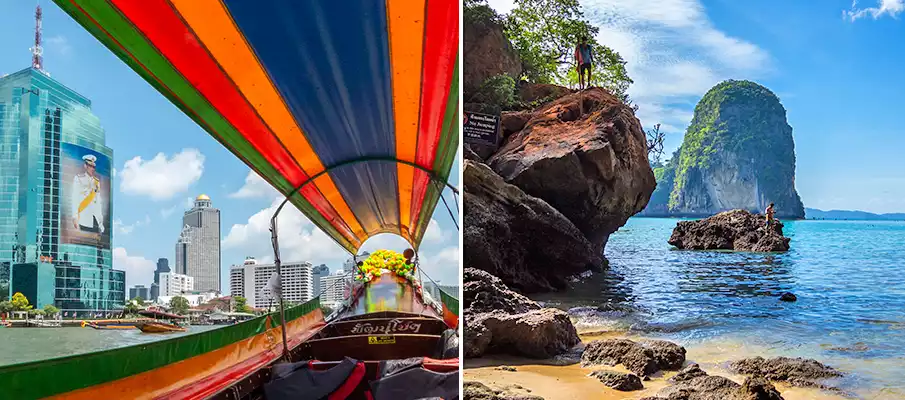
10 Important Historical Sites / Temples in Thailand:
Thailand’s historical sites and temples are a treasure trove of the country’s rich heritage and cultural legacy. Each site narrates a compelling story of ancient civilizations, religious devotion, and architectural brilliance, providing visitors with a profound insight into Thailand’s illustrious past.
-
- 1. Wat Pho (Bangkok): Also known as the Temple of the Reclining Buddha, Wat Pho is one of Bangkok’s oldest and most significant temples. It houses a massive reclining Buddha statue measuring 46 meters long and is renowned for being Thailand’s first public university.
- 2. Ayutthaya Historical Park (Ayutthaya): A UNESCO World Heritage site, the Ayutthaya Historical Park preserves the remains of the ancient capital of the Ayutthaya Kingdom. Visitors can explore impressive temple ruins, statues, and historical sites that offer glimpses into Thailand’s glorious past.
- 3. Wat Arun (Bangkok): The Temple of Dawn, Wat Arun, is an iconic landmark on the banks of the Chao Phraya River. Its towering prang (Khmer-style tower) and intricate ceramic mosaic design make it a significant cultural and architectural treasure.
- 4. The Grand Palace (Bangkok): The Grand Palace is a majestic complex that served as the official residence of Thai monarchs for generations. It houses the exquisite Wat Phra Kaew, enshrining the revered Emerald Buddha, Thailand’s most sacred religious icon.
- 5. Sukhothai Historical Park (Sukhothai): Another UNESCO World Heritage site, Sukhothai Historical Park showcases the ruins of the Sukhothai Kingdom, often regarded as the cradle of Thai civilization. The site features well-preserved temples, stupas, and historical structures in a serene park setting.
- 6. Phanom Rung Historical Park (Buriram): Phanom Rung is a stunning Khmer temple complex perched on an extinct volcano. Its architecture reflects the grandeur of the ancient Khmer Empire, and during certain periods of the year, the sun aligns perfectly with the temple’s entrance.
- 7. Wat Phra Singh (Chiang Mai): One of Chiang Mai’s most revered temples, Wat Phra Singh houses the Phra Singh Buddha image, considered one of the most beautiful Buddha statues in Thailand. The temple’s impressive Lanna architecture and serene ambiance attract visitors and devotees alike.
- 8. Prasat Hin Phimai (Nakhon Ratchasima): Prasat Hin Phimai is an ancient Khmer temple built during the reign of the Khmer Empire. It bears a striking resemblance to Cambodia’s Angkor Wat and reflects the once-vast influence of the Khmer civilization in the region.
- 9. Wat Phra Mahathat Woramahawihan (Nakhon Si Thammarat): One of the oldest and most significant temples in Thailand, Wat Phra Mahathat Woramahawihan is a revered religious site housing a sacred Buddha relic. The temple’s impressive pagoda is a symbol of southern Thai architecture.
- 10. Wat Chedi Luang (Chiang Mai): Located in the heart of Chiang Mai, Wat Chedi Luang is an ancient temple that once housed the revered Emerald Buddha. Its towering chedi (stupa) and intricate stone carvings reflect the architectural brilliance of the Lanna Kingdom.
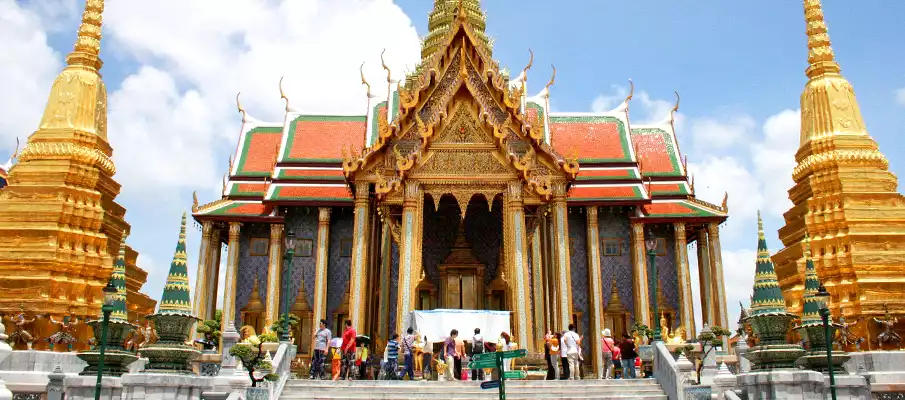
Famous Tourist and Beautiful Islands in Thailand:
Thai islands, renowned for their exotic beauty and hospitality, represent a unique slice of paradise on Earth. Each of these islands has its own charm and offers visitors various experiences. Some are more frequented, while others are a bit less known. Prominent destinations like Koh Phangan, Koh Samui, and Phuket have their own attractions for those seeking an active vacation, nightlife, and luxury. On the other hand, quieter islands such as Koh Kood, Koh Lanta, and Koh Lipe offer relaxation, stunning beaches, and a unique culture. Also, check out the article 13 Best Islands in Thailand.
-
- Koh Phangan: Koh Phangan, situated in the Gulf of Thailand, is famous for its beautiful beaches and legendary full moon parties. This island is a favorite destination for beach lovers but also offers a rich culture and traditional Thai cuisine. Local markets, historic temples, and jungles provide experiences of extraordinary character.
-
- Koh Kood: Koh Kood is a tranquil and unspoiled paradise island in Thailand. With its white sandy beaches and lush nature, it’s an ideal place for those seeking absolute relaxation away from the tourist crowds. The island is dotted with numerous waterfalls, adding a touch of adventure to its charm.
-
- Koh Chang: Koh Chang, also known as the „Elephant Island,“ is among the gems of the Gulf of Thailand. It offers beautiful beaches, jungles, and adventure around every corner. The island is an ideal place for nature enthusiasts, water sports lovers, and hikers.
-
- Koh Samui: Koh Samui is one of the most famous Thai islands, known for its luxury resorts, vibrant nightlife, and rich culture. It’s an ideal place for those seeking a blend of relaxation and entertainment. The island also hides traditional Thai villages and landmarks inviting you to explore the local way of life.
-
- Koh Tao: Koh Tao, known as the „Diver’s Paradise,“ is a haven for divers and underwater enthusiasts. With mesmerizing coral reefs, crystal-clear waters, and a diverse marine life, Koh Tao offers unique opportunities to explore the underwater world.
-
- Phuket: Phuket, Thailand’s largest island, is a popular tourist destination. It offers diverse entertainment options, from beautiful beaches to nightlife, and from jungle adventures to historical and cultural landmarks. Phuket combines modern comfort with traditional Thai ambiance.
-
- Koh Phi Phi: Koh Phi Phi, with its stunning limestone cliffs and crystal-clear waters, ranks among the most beautiful islands in Thailand. It’s an ideal place for diving enthusiasts but also for those yearning for beautiful beaches and picturesque vistas.
-
- Koh Lipe: Koh Lipe is a small island in the Andaman Sea, known for its white sandy beaches and transparent waters. This romantic retreat is an ideal destination for those seeking beach relaxation and an escape from the hustle and bustle of civilization. The island also offers opportunities for diving and snorkeling in a beautiful marine environment.
-
- Koh Lanta: Koh Lanta is a peaceful and relaxing island with beautiful beaches and water sports opportunities. The island is an ideal place for rest and exploring nature, and it also offers authentic Thai villages and traditional cuisine.
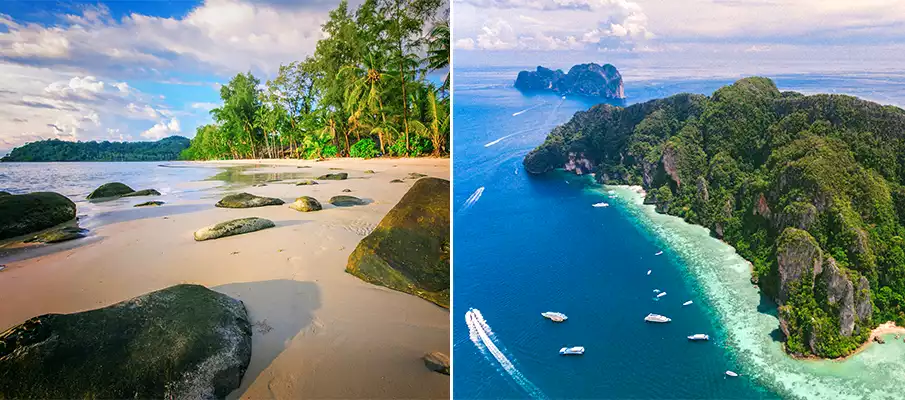
Activities and Adventure for tourists visiting Thailand:
Thailand’s activities and adventures cater to every taste, from nature enthusiasts to thrill-seekers and culture lovers. With a wide range of exciting experiences, tourists can create cherished memories and embrace the unique wonders of this captivating Southeast Asian nation.
-
- 1. Scuba Diving and Snorkeling: Thailand’s pristine waters and vibrant marine life make it a diver’s paradise. Islands like Koh Tao, Koh Phi Phi, and Similan Islands offer world-class scuba diving and snorkeling opportunities. Explore coral reefs, encounter colorful marine species, and discover underwater wonders.
- 2. Elephant Sanctuaries: Interacting with elephants in ethical sanctuaries is a unique and rewarding experience. Places like Elephant Nature Park in Chiang Mai and Elephant Hills in Khao Sok allow tourists to observe and care for these majestic creatures in a responsible and compassionate manner.
- 3. Trekking and Hiking: Northern Thailand, with its mountainous landscapes and lush jungles, offers excellent trekking and hiking adventures. Head to Chiang Mai or Pai to explore nature trails, encounter hill tribe villages, and witness stunning waterfalls.
- 4. Zip Lining and Canopy Tours: Thrill-seekers can enjoy zip-lining and canopy tours amidst the treetops of Thailand’s lush rainforests. Locations like Flight of the Gibbon in Chiang Mai and Pattaya’s Flight of the Gibbon offer exhilarating experiences with breathtaking views.
- 5. Rock Climbing: Krabi and Railay Beach are renowned rock climbing destinations, attracting climbers of all levels. The limestone cliffs provide a challenging yet rewarding experience amidst stunning coastal vistas.
- 6. White Water Rafting: The wild rivers of northern Thailand, particularly around Chiang Mai and Pai, offer opportunities for exhilarating white water rafting. Navigate through rapids and gorges for an adrenaline-pumping adventure.
- 7. Thai Cooking Classes: For food enthusiasts, Thai cooking classes are a must-do activity. Learn to prepare traditional Thai dishes, discover local ingredients, and savor the flavors of authentic Thai cuisine.
- 8. Muay Thai Training: Experience the art of Muay Thai, Thailand’s national sport and martial art. Training camps in places like Bangkok, Chiang Mai, and Phuket offer classes for both beginners and experienced practitioners.
- 9. Floating Markets and River Cruises: Explore the charm of floating markets, such as Damnoen Saduak and Amphawa, where vendors sell fresh produce and local delicacies from their boats. Enjoy leisurely river cruises along the Chao Phraya River, offering scenic views of historic landmarks.
- 10. Festival Celebrations: Immerse yourself in Thai culture by attending festivals like Songkran (Thai New Year) and Loy Krathong (Festival of Lights). Participate in water fights during Songkran or release decorated floats into waterways during Loy Krathong for a memorable cultural experience.
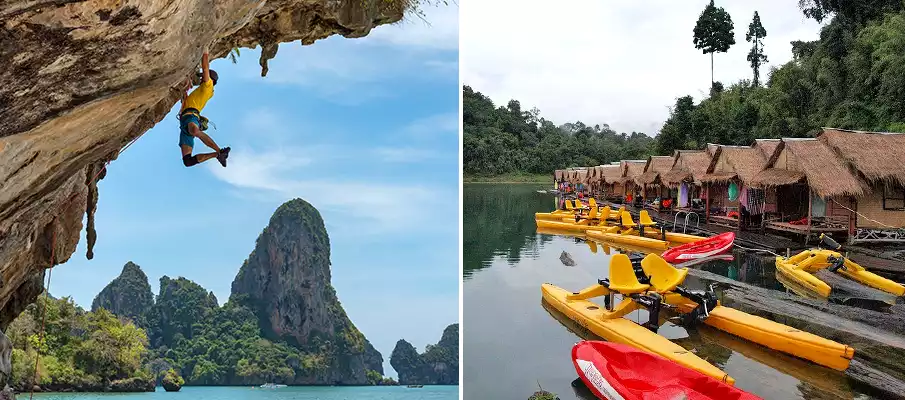
How to Behave and What to Watch Out for in Thailand?
If you’re planning to travel to Thailand, it’s important to respect local customs and traditions and follow some rules to make your trip as safe and enjoyable as possible. It’s crucial to realize that you’re entering a completely different cultural environment than what you’re familiar with in Europe. Here are some tips on how to behave and what to watch out for in Thailand:
-
- Clothing: Respect local culture and dress with significant respect for the place. Cover your shoulders and knees, especially when visiting temples and sacred places.
-
- Display of Religion: Thai society is very religious, predominantly Buddhism. Observe basic rules and avoid showing disrespect to Buddhist sanctuaries.
-
- Footwear: Always remove your shoes before entering buildings and certain important or sacred homes.
-
- Modesty: Public displays of affection, like holding hands, are not something that local people publicly engage in. If you’re a couple, be discreet.
-
- Respect for Locals: Local residents are friendly and kind. Show them respect and courtesy, and avoid displaying hostile behavior.
-
- Observe Laws: Respect local laws and regulations. The Thai government takes a tough stance on certain criminal activities, including drug consumption.
-
- Safety: Remember basic personal safety measures. Keep an eye on your valuables and avoid risky areas.
-
- Road Safety: Road traffic in Thailand can be chaotic. Be cautious when driving or walking on the road.
-
- Food and Water: If you’re eating street food, ensure that the food is well cooked. Drink bottled water if tap water is not potable.
-
- Negotiation: When shopping at markets and stores, be mindful of the art of negotiation. Prices are not always fixed, and you can attempt to haggle with the seller.
-
- Healthcare: Have valid travel insurance and follow current vaccination recommendations. In case of health issues, seek local medical care.
-
- Nature Conservation: Respect nature and preserve Thailand’s natural beauty. Do not touch coral while snorkeling or diving, and do not litter in the environment.
These traveler tips and advice should help you travel through Thailand with respect for local traditions and stay safe. Thailand’s attractions, culture, and cuisine are amazing, and by respecting local customs, you’ll be able to fully enjoy your journey and travel in this country.
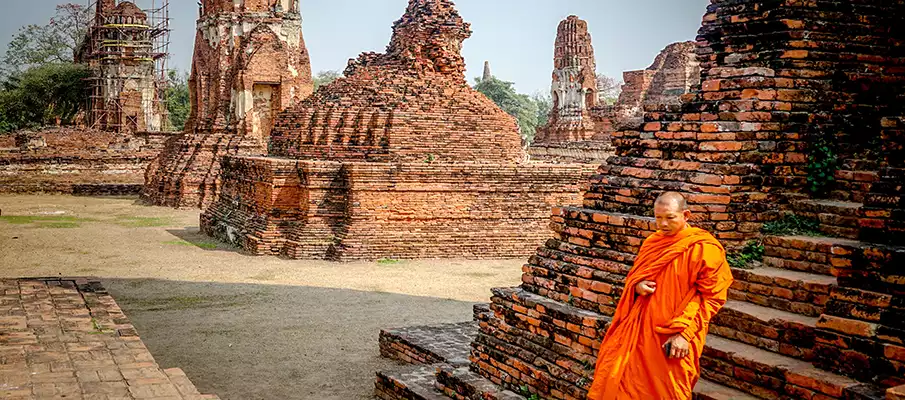
Is it suitable to travel to Thailand with children?
Certainly, traveling to Thailand with children is a suitable choice, and many families enjoy their vacations in this country. Thailand offers diverse options for families with children, including beautiful beaches, fascinating culture, adventurous activities, and delicious Thai cuisine.
Here are some factors to consider when traveling to Thailand with children:
-
- Health and Safety: Ensure that you have up-to-date vaccinations and malaria prophylaxis if you plan to visit areas where malaria is a risk. Pay attention to hygiene and protect against mosquitoes.
-
- Food: Thai cuisine is delicious but can be spicy. If your children don’t like spicy food, you can request a less spicy version of the dish. Always make sure that your children drink bottled or purified water.
-
- Activities: Thailand offers many family-friendly activities, such as temple visits, beach swimming, elephant camps, visits to zoos, and trips to exotic islands. You can also try traditional Thai massages and relax on the beach.
-
- Travel: Thailand has a well-developed infrastructure, and you can use various modes of transportation, including tuk-tuks, taxis, trains, and domestic flights. Children may be interested in traditional Thai ferries and elephant rides.
-
- Culture and Respect: Teach your children about Thai culture and encourage them to be considerate and respectful of local customs and traditions, including showing respect for Buddhist temples.
-
- Safety: Thailand is generally considered a safe destination, but it’s essential to take common-sense precautions, such as keeping an eye on your valuables and avoiding risky areas.
Since every family has its own needs and preferences, it’s important to plan your trip carefully and choose destinations (e.g. Phuket or Krabi) and activities that are suitable for your children. However, Thailand offers many opportunities for fun and adventure for the whole family.
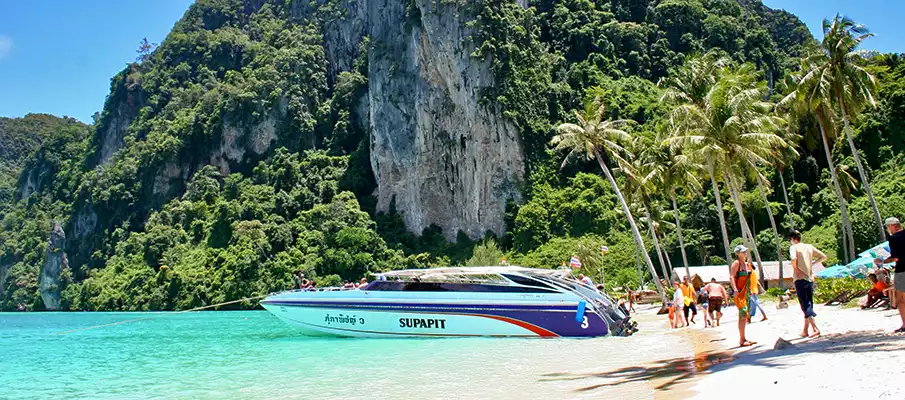
What to Bring from Thailand? What Tourist Souvenirs?
Thailand, the land of mesmerizing temples, tropical beaches, and hospitable people, not only offers unforgettable experiences but also a rich array of souvenirs that will transport you to the heart of Thai culture. While exploring traditional markets and shops, you’ll encounter a wide range of items, from handmade crafts to delightful treats from Thai cuisine. Here are some of these treasures that might remind you of your unforgettable journey to Thailand:
-
- Batik Textiles: Thailand is renowned for its handmade batik textiles. Vibrant patterns on fabrics create beautiful designs, often depicting traditional Thai motifs such as flowers, Buddhist monks, and symbols of good luck.
-
- Clay Products: Handmade ceramic and clay products are popular among tourists. Thai ceramics often feature intricate patterns and a vivid color palette. Vases, plates, and bowls are excellent ways to bring home a piece of traditional Thai craftsmanship.
-
- Traditional Khon Mask: Khon is a traditional Thai theater, and the masks used in these performances are artistic treasures. Made from wood or paper, they represent characters from Thai mythology, creating fascinating and authentic pieces of art.
-
- Coconut Products: Thanks to abundant coconut plantations, Thailand offers a variety of coconut products, including oils, soaps, creams, and even decorative items made from coconut shells.
-
- Traditional Thai Clothing: Known for its comfort and vibrant colors, Thai clothing is a popular choice for souvenirs. Bring home a traditional Thai skirt called „sarong“ or „sinh.“ These garments not only represent local fashion but also serve as a great way to bring a piece of Thai style into your home.
-
- Gemstone Jewelry: Thailand is home to several rare gemstones, such as sapphires and rubies. Acquiring traditional Thai jewelry can be not only a beautiful accessory but also affordable, thanks to these local gemstones.
-
- Spices and Blends: Thai cuisine is renowned for its spicy and aromatic flavors. Bring home spice blends like red or green curry paste, lemongrass, galangal, and kaffir lime leaves. These ingredients form the foundation for preparing authentic Thai dishes.
Thailand offers a wide range of products that can be brought as souvenirs, capturing the beauty and richness of Thai culture. Whether you opt for traditional crafts, fashion, or exquisite gemstones, each item will serve as a reminder of the splendor of Thailand.
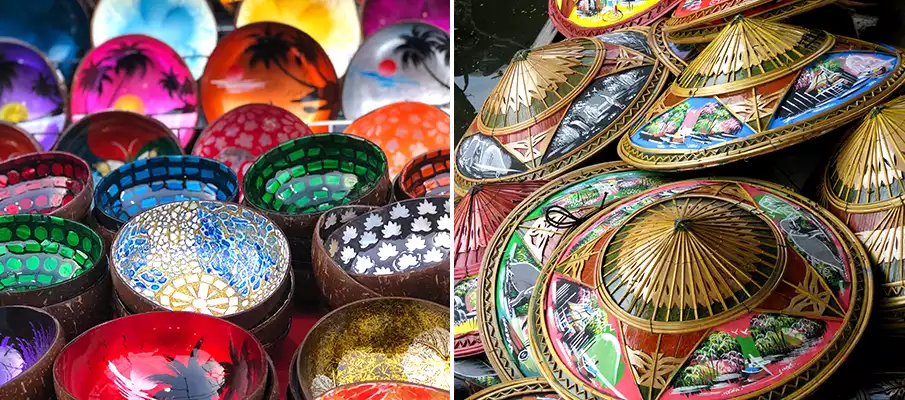
Food and Cuisine in Thailand / Popular Foods:
Thailand’s culinary landscape is a symphony of flavors, where sweet, spicy, sour, and savory tastes come together to create a gastronomic paradise. From aromatic street food to exquisite dishes served in restaurants, Thai cuisine is renowned worldwide for its delectable offerings and vibrant culinary traditions.
Popular Thai Foods: A Taste Sensation
-
- Pad Thai: Perhaps the most famous Thai dish, Pad Thai is a stir-fried noodle dish typically made with rice noodles, eggs, tofu, shrimp or chicken, bean sprouts, and crushed peanuts. The savory-sweet flavors, combined with a hint of tamarind, make it an irresistible street food favorite.
- Tom Yum Goong: A spicy and sour shrimp soup, Tom Yum Goong is a tantalizing blend of lemongrass, lime leaves, galangal, lime juice, and chili. The aromatic broth is filled with succulent shrimp, making it a refreshing and comforting dish.
- Green Curry (Kaeng Khiao Wan): A fragrant Thai curry, Green Curry is made with green chilies, coconut milk, and a medley of herbs and spices. Often served with chicken or seafood and bamboo shoots, this creamy and flavorful curry is a culinary delight.
- Som Tum (Green Papaya Salad): This refreshing and zesty salad features shredded green papaya, tomatoes, green beans, peanuts, and lime dressing. The combination of sweet, sour, and spicy flavors creates a delightful explosion of tastes.
- Massaman Curry: A fusion of Thai and Indian influences, Massaman Curry is a mild and creamy curry flavored with cardamom, cinnamon, peanuts, and tender chunks of meat or vegetables.
- Mango Sticky Rice (Khao Niew Mamuang): A beloved Thai dessert, Mango Sticky Rice combines sweet and creamy ripe mango slices with coconut-infused sticky rice, drizzled with a luscious coconut milk sauce.
- Tom Kha Gai: A coconut milk-based soup, Tom Kha Gai is a cousin of Tom Yum Goong, but with a milder and creamier profile. It features chicken, mushrooms, galangal, and kaffir lime leaves for a comforting and aromatic delight.
- Papaya Salad (Som Tum Thai): A variation of green papaya salad, Som Tum Thai includes fermented fish sauce, garlic, and extra chili for an extra kick. It’s a popular side dish that perfectly complements grilled meats.
- Panang Curry (Kaeng Phanaeng): Panang Curry is a rich and flavorful Thai curry that features beef or chicken in a creamy coconut milk base, enriched with Panang curry paste and topped with kaffir lime leaves.
- Tom Kha Talay: Similar to Tom Kha Gai, this seafood version of the soup includes a delectable combination of prawns, squid, and fish, providing a taste of Thailand’s coastal bounty.
BOOK a TOUR / ACTIVITY in Thailand ➜
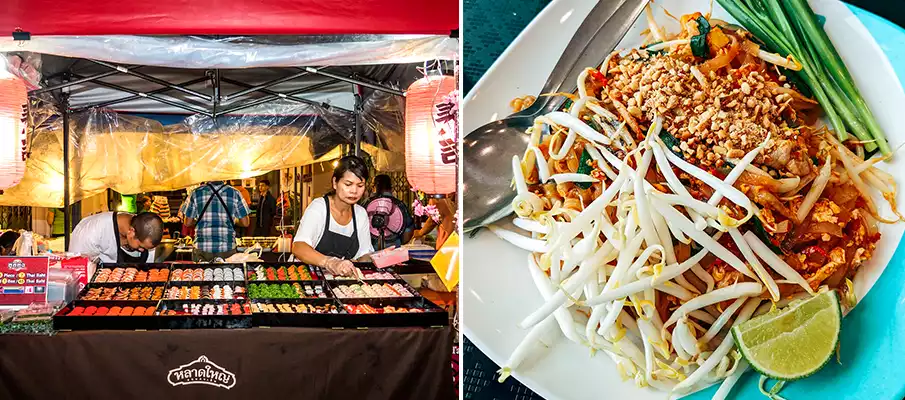
Why to visit or not to visit Thailand?
Thailand’s allure as a travel destination lies in its enchanting landscapes, rich culture, and warm hospitality. While it offers unforgettable experiences, travelers should be mindful of seasonal considerations, cultural sensitivities, and responsible travel practices to make the most of their journey to this captivating Southeast Asian gem.
👉 Reasons to visit Thailand:
-
- Stunning Natural Beauty: Thailand boasts breathtaking landscapes, from pristine beaches with turquoise waters to lush jungles and towering limestone cliffs. Whether you seek relaxation or adventure, Thailand’s diverse scenery offers something for everyone.
- Rich Cultural Heritage: With ancient temples, historic sites, and vibrant festivals, Thailand is a treasure trove of cultural delights. Immerse yourself in the traditions, art, and spirituality that define this captivating nation.
- Delicious Cuisine: Thai food is renowned worldwide for its flavorful blend of sweet, sour, spicy, and savory tastes. Experience the tantalizing street food, sumptuous curries, and tropical fruits that will delight your taste buds.
- Warm Hospitality: The Thai people are known for their warm smiles and genuine friendliness. Visitors are welcomed with open arms, creating an inviting and hospitable atmosphere throughout the country.
- Adventure and Activities: From diving in crystal-clear waters to trekking in the jungles, Thailand offers a wide array of thrilling activities for adventure enthusiasts. Zip-lining, rock climbing, and exploring ancient ruins add excitement to any itinerary.
- Affordable Travel: Thailand is a budget-friendly destination, offering a range of accommodations, food options, and transportation choices to suit all budgets. You can experience a lot without breaking the bank.
👉 Reasons not to visit Thailand:
-
- Monsoon Season: Thailand experiences a monsoon season with heavy rainfall and potential disruptions to outdoor activities, particularly from June to October. Travelers may prefer to avoid this period for a more enjoyable experience.
- Crowded Tourist Spots: Popular tourist attractions can get crowded, especially during peak seasons. It’s advisable to plan visits early in the day or explore lesser-known spots for a more tranquil experience.
- Cultural Respect: Travelers must be mindful of Thai customs and cultural norms, such as dressing modestly in temples and respecting local traditions. Failure to do so may inadvertently offend locals.
- Heat and Humidity: Thailand’s tropical climate can be hot and humid, which may not be ideal for everyone. It’s essential to stay hydrated and take precautions against the heat, especially during the summer months.
- Tourist Scams: Like in any tourist destination, some scams and touts may target unsuspecting travelers. Being vigilant and informed can help avoid falling victim to such situations.
- Environmental Impact: With the rise in tourism, some areas in Thailand face environmental challenges. Responsible travel practices, such as avoiding single-use plastics and participating in sustainable tours, can help minimize the impact.
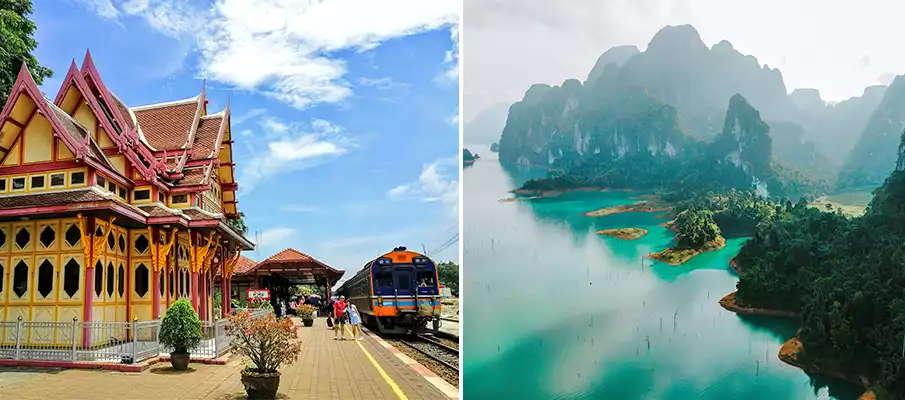
✈️ How to get and travel to Thailand?
Thailand is a well-connected country with multiple entry points, making it relatively easy to reach from various parts of the world. The most popular and fastest options are international flights. You can also arrive to Thailand from Malaysia, Laos, Myanmar or Cambodia by bus. Here are some common ways to get to Thailand and travel within the country:
1. Transfer by Air to Thailand:
- International Flights: Thailand has several international airports, with Suvarnabhumi Airport in Bangkok being the primary gateway. It serves numerous direct flights from major cities worldwide. Other international airports include Don Mueang Airport in Bangkok, Phuket International Airport, and Chiang Mai International Airport.
- Domestic Flights: Domestic flights are a convenient option for traveling between major cities and popular tourist destinations within Thailand. Airlines such as Thai Airways, Bangkok Airways, and low-cost carriers like AirAsia and Nok Air operate domestic routes.
2. Transfer by Land to Thailand:
- Neighboring Countries: If you are traveling from neighboring countries like Cambodia, Laos, Myanmar, or Malaysia, you can cross the land border into Thailand. Popular border crossings include Aranyaprathet / Poipet (Thailand-Cambodia), Chiang Khong/Huay Xai (Thailand-Laos), and Mae Sai/Tachileik (Thailand-Myanmar).
3. Transfer by boat to Thailand:
- Cruise Ships: Some cruise lines offer itineraries that include ports of call in Thailand, typically at Phuket or Bangkok.
- You can book tickets / flights to Thailand on Baolau ➜ or 12go.asia ➜
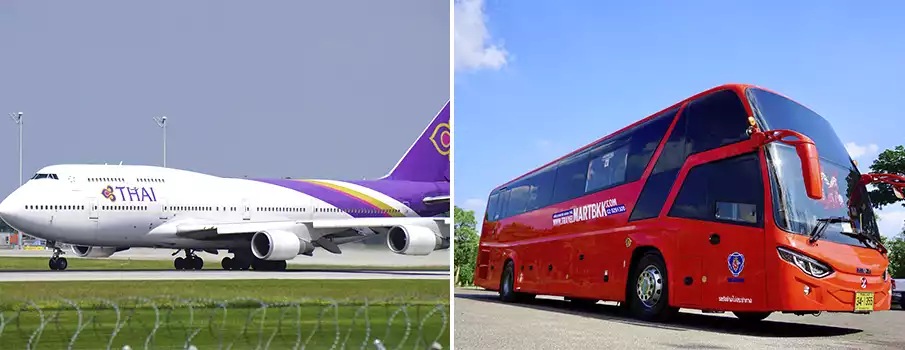
🚍 What are the Transport Options in Thailand?
Thailand offers a variety of transport options to cater to different preferences and budgets. From bustling cities to serene islands, here are the main modes of transport you can use to explore the country:
-
- 1. Tuk-Tuks and Songthaews: Tuk-tuks, three-wheeled motorized taxis, are a common sight in cities and towns. They provide quick rides for short distances, although fares are often negotiable. Songthaews are shared pick-up trucks that operate on fixed routes and are a cost-effective way to travel within cities.
- 2. Buses: Thailand’s bus network is extensive and connects cities, towns, and villages across the country. Public buses are economical, while VIP buses offer more comfort for longer journeys. Both air-conditioned and non-air-conditioned buses are available.
- 3. Trains: The Thai railway system links major cities, including Bangkok, Chiang Mai, and Surat Thani (for access to the islands). Overnight sleeper trains are popular for long-distance travel, providing both cost-effective accommodation and transportation.
- 4. Domestic Flights: Thailand has a well-developed domestic air travel network, with multiple airlines offering flights between major cities and tourist destinations. Bangkok is the primary hub, but other cities like Chiang Mai, Phuket, and Krabi also have domestic airports.
- 5. Long-Distance Taxis: For more comfort and convenience, long-distance taxis or private car services can be arranged. They are ideal for group travel or exploring off-the-beaten-path destinations.
- 6. Motorbikes and Scooters: Renting a motorbike or scooter is popular in many tourist areas, providing flexibility and independence. However, it’s essential to wear helmets, obey traffic rules, and exercise caution, especially in busy urban areas.
- 7. Ferries and Boats: Thailand’s coastal regions and islands are accessible by ferries and boats. Ferries link mainland ports to popular islands like Koh Samui, Koh Phi Phi, and Koh Phangan. Speedboats offer quicker transfers between islands.
- 8. Domestic Cruise Lines: Some domestic cruise lines offer river cruises along the Chao Phraya River in Bangkok or explore other scenic waterways in Thailand.
- 9. Rental Cars: Renting a car allows for greater exploration of remote areas and scenic drives. However, driving in urban centers can be challenging due to traffic congestion.
- 10. Domestic Tour Operators: For organized trips to specific destinations or attractions, domestic tour operators offer package tours and excursions that cater to various interests and budgets.
- You can book tickets / flights in Thailand on Baolau ➜ or 12go.asia ➜
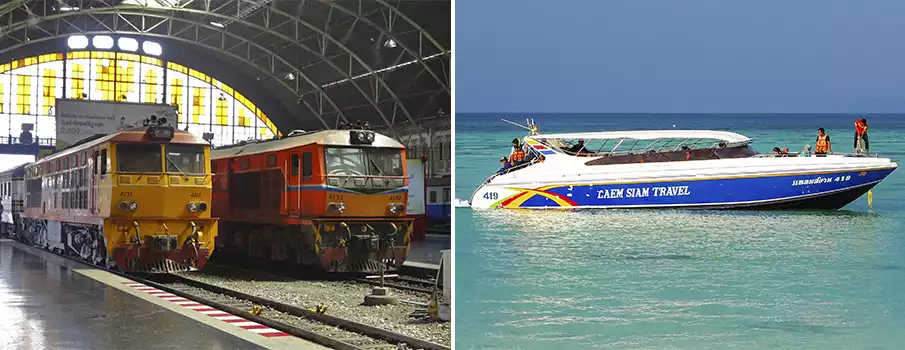
☀️ Weather in Thailand + The Best Time to Visit:
Thailand experiences a tropical climate, characterized by hot and humid weather throughout most of the year. The country’s diverse geography and regional variations result in different weather patterns in different parts of Thailand. Understanding the climate can help you plan the best time to visit based on your preferences and desired activities.
1. Dry Season in Thailand:
-
- The dry season generally lasts from November to April, with variations depending on the region.
- November to February: This period is considered the high season for tourism as temperatures are milder, and there is minimal rainfall. It is an ideal time for sightseeing, beach activities, and exploring cities.
- March to April: These months can be hot, particularly in the central and northern regions. It’s an excellent time for beachgoers, but travelers should be prepared for higher temperatures.
2. Hot Season in Thailand:
-
- The hot season typically extends from March to May, with temperatures peaking in April. This season is marked by high temperatures and humidity, particularly in central and northern Thailand. Coastal areas and islands may offer a bit of respite due to sea breezes.
3. Wet Season in Thailand:
-
- The wet season generally occurs from May to October, with regional variations in rainfall patterns.
- May to October: This period sees increased rainfall and occasional thunderstorms. While it may not rain every day, showers can be heavy and sudden. The southwest monsoon affects the Andaman Coast (Phuket, Krabi) and the western Gulf Coast (Koh Samui, Koh Phangan) from May to October. The eastern Gulf Coast (Koh Chang, Pattaya) experiences its rainy season from September to October.
4. Best Time to Visit Thailand:
-
- The best time to visit Thailand depends on your preferences and the activities you plan to undertake. For most travelers, the cool and dry season from November to February is considered the optimal time to explore the country. This period offers pleasant temperatures, lower humidity, and minimal rainfall, making it ideal for sightseeing, outdoor adventures, and beach vacations.
5. Special Considerations:
-
- Festivals: Some travelers might want to plan their visit around famous Thai festivals, such as Songkran (Thai New Year) in mid-April or Loy Krathong (Festival of Lights) in November. These celebrations offer unique cultural experiences and vibrant festivities.
- Diving and Snorkeling: If diving and snorkeling are on your agenda, the wet season can provide better underwater visibility, particularly on the Andaman Coast.
| Month | Weather | Description |
|---|---|---|
| January | Cool and Dry | In January, Thailand experiences cool and dry weather, making it an ideal time to visit. Explore the cultural wonders of Bangkok, the ancient ruins of Ayutthaya, and the beautiful beaches of Phuket without the scorching heat of other months. |
| February | Cool and Dry | February continues with cool and dry conditions, providing perfect weather for outdoor activities and sightseeing. Discover the bustling street markets of Chiang Mai and participate in the colorful festivities of the Chiang Mai Flower Festival. |
| March | Warm and Dry | March brings warmer temperatures, but it’s still dry and comfortable for exploring. Enjoy the vibrant nightlife of Pattaya, relax on the stunning beaches of Koh Samui, and witness the annual Thai New Year celebration, Songkran. |
| April | Hot and Dry | April is hot and dry in Thailand, with temperatures rising. It’s an excellent time to experience the traditional Thai culture in Sukhothai during the Songkran Festival and admire the ancient ruins of Ayutthaya. |
| May | Hot and Wet | May marks the beginning of the wet season, with increasing humidity and occasional showers. While the rain may offer relief from the heat, it’s advisable to pack rain gear. Explore the bustling markets of Bangkok and the lush jungles of Chiang Rai. |
| June | Hot and Wet | June continues with hot and wet weather, with more frequent rainfall. It’s a quieter time for tourism, allowing you to explore the temples of Ayutthaya and the historic city of Sukhothai with fewer crowds. |
| July | Hot and Wet | July remains hot and wet, experiencing occasional heavy rain showers. Discover the ancient ruins of Ayutthaya and the vibrant markets of Chiang Mai, and experience the unique Yi Peng Lantern Festival. |
| August | Hot and Wet | August continues with hot and wet weather, making it an ideal time for indoor activities like exploring the Grand Palace in Bangkok and visiting museums. |
| September | Hot and Wet | September experiences hot and wet weather, with occasional heavy rainfall. It’s a quieter time for tourism, but you can still explore the ancient ruins of Ayutthaya and the natural beauty of Khao Sok National Park. |
| October | Cool and Wet | October brings cooler temperatures with ongoing rain. The landscapes are lush and green during this time, making it a beautiful season for photography and exploring the waterfalls of Erawan National Park. |
| November | Cool and Dry | November offers cooler temperatures and less rain, making it an excellent time to visit Thailand. Explore the historical sites of Sukhothai and the lively markets of Bangkok. |
| December | Cool and Dry | December experiences cool and dry weather, perfect for outdoor activities and sightseeing. Celebrate the festive season in Bangkok and enjoy the beautiful beaches of Koh Phi Phi and Krabi. |
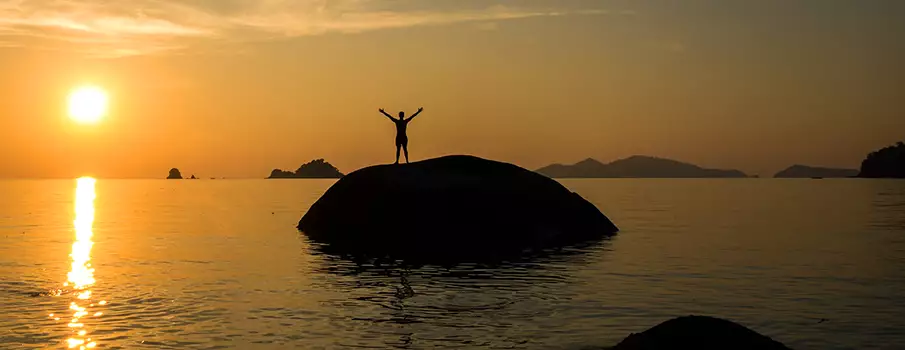
🏡 Accommodation in Thailand / Where to stay:
Thailand, known for its warm hospitality and diverse landscapes, offers a wide range of accommodation choices to suit every traveler’s preferences and budget. From luxurious beach resorts to budget-friendly hostels, there’s something for everyone in this enchanting Southeast Asian nation.
-
- 1. Luxury Resorts and Hotels: Thailand boasts a plethora of luxurious resorts and hotels, particularly in popular tourist destinations like Phuket, Koh Samui, and Bangkok. These properties offer world-class amenities, stunning views, private beaches, spa facilities, and exceptional service, ensuring a truly indulgent experience.
- 2. Boutique and Design Hotels: For travelers seeking unique and stylish accommodations, Thailand’s boutique and design hotels fit the bill. These properties often boast modern decor, artful touches, and a more intimate ambiance, providing a charming and sophisticated stay.
- 3. Mid-Range Hotels and Guesthouses: Mid-range hotels and guesthouses are abundant across Thailand, catering to travelers who seek comfort and value for money. These properties offer well-appointed rooms, basic amenities, and a pleasant stay without breaking the bank.
- 4. Budget-Friendly Hostels: Backpackers and budget travelers will find an array of affordable hostels in Thailand’s major cities and tourist hubs. Hostels provide dormitory-style accommodations with shared facilities, creating opportunities for socializing and making new friends.
- 5. Guesthouses and Homestays: In more remote areas and smaller towns, guesthouses and homestays offer a glimpse into authentic Thai hospitality. These family-run establishments provide a more personal experience, allowing travelers to immerse themselves in local culture.
- 6. Beach Bungalows: On Thailand’s idyllic islands and coastal regions, beach bungalows are a popular option. These rustic yet charming accommodations are often situated right on the beach, offering a laid-back and nature-immersed stay.
- 7. Eco-Lodges and Nature Retreats: For eco-conscious travelers, Thailand offers eco-lodges and nature retreats, especially in areas of pristine wilderness and national parks. These accommodations prioritize sustainable practices and provide opportunities to connect with nature.
- 8. Floating Bungalows: In certain areas, such as Khao Sok National Park, floating bungalows on serene lakes offer a unique and tranquil escape surrounded by lush scenery.
- 9. Airbnb and Vacation Rentals: In urban centers and tourist destinations, Airbnb and vacation rentals provide additional options for those seeking more independent and homely accommodations.
- 10. Glamping and Luxury Tents: Glamping options have emerged in Thailand, offering luxurious tented accommodations with all the comforts of a high-end hotel. These experiences combine outdoor adventures with lavish amenities.
➜ Accommodation in Thailand – Book Here
🔍 Interesting Places + Activities in Thailand:
-
- Grand Palace and Wat Phra Kaew (Bangkok): The Grand Palace, a symbol of Thailand’s rich history and architectural beauty, is a must-visit in Bangkok. Within its sprawling complex lies Wat Phra Kaew, the Temple of the Emerald Buddha, showcasing a revered Buddha image carved from a single jade stone. Admire intricate golden spires, colorful murals, and exquisite Thai craftsmanship.
-
- Floating Markets (Damnoen Saduak and Amphawa): Experience the charm of Thailand’s floating markets, where vendors sell fresh fruits, vegetables, and handicrafts from wooden boats navigating through narrow waterways. Damnoen Saduak and Amphawa markets offer a glimpse into traditional Thai life along the canals.
-
- Ayutthaya Historical Park (Ayutthaya): Explore the ancient capital of Ayutthaya, once a thriving kingdom and now a UNESCO World Heritage site. Discover the impressive ruins of temples and palaces, including Wat Mahathat and Wat Phra Si Sanphet, reflecting the glory of a bygone era.
-
- Chiang Mai Night Bazaar (Chiang Mai): In the heart of Chiang Mai’s old city, the bustling night bazaar comes alive with stalls selling handicrafts, textiles, clothing, and local artwork. Taste delectable street food while immersing yourself in the vibrant atmosphere.
-
- Phi Phi Islands (Krabi Province): Embark on a boat trip to the Phi Phi Islands, including Phi Phi Don and Phi Phi Leh. Relax on stunning beaches, snorkel in clear waters teeming with marine life, and marvel at the famous Maya Bay featured in the movie „The Beach.“
-
- Railay Beach (Krabi): Accessible only by boat due to its limestone cliffs, Railay Beach is a rock climber’s paradise. Scale the cliffs to enjoy breathtaking views or simply unwind on the sandy shores surrounded by picturesque scenery.
-
- Elephant Nature Park (Chiang Mai): Escape unethical elephant tourism and visit Elephant Nature Park, a sanctuary dedicated to the well-being and conservation of elephants. Observe these gentle giants in their natural habitat and participate in responsible interactions.
-
- Full Moon Party (Koh Phangan): Join the world-renowned Full Moon Party on Koh Phangan’s Haad Rin Beach. This monthly event attracts revelers from around the globe who dance the night away under the glowing moon, accompanied by music, fire shows, and beachside fun.
-
- Erawan National Park (Kanchanaburi): Venture to Erawan National Park to witness the enchanting seven-tiered Erawan Waterfall. Enjoy cooling off in the emerald-green pools, surrounded by lush tropical forest and diverse wildlife.
-
- Scuba Diving in Similan Islands: Renowned among diving enthusiasts, the Similan Islands offer crystal-clear waters, vibrant coral reefs, and encounters with marine creatures like manta rays and whale sharks. Dive into an underwater paradise brimming with biodiversity.
-
- Sukhothai Historical Park (Sukhothai): Step back in time at the Sukhothai Historical Park, where you’ll find well-preserved ruins of ancient temples and monuments. Rent a bicycle to explore the vast complex, and witness the magnificent architecture of the Sukhothai Kingdom.
-
- Kanchanaburi’s Death Railway: Pay tribute to history at the Death Railway Bridge and Museum in Kanchanaburi. The bridge, constructed during World War II by prisoners of war, stands as a poignant reminder of the sacrifices made during the war.
-
- Doi Suthep Temple (Chiang Mai): Climb the Naga Staircase to reach Doi Suthep Temple, perched atop Doi Suthep Mountain. This sacred site offers panoramic views of Chiang Mai city and houses a gleaming golden pagoda, attracting both locals and visitors seeking blessings and peace.
-
- Khao Sok National Park (Surat Thani): Be immersed in the untouched beauty of Khao Sok National Park, one of the world’s oldest rainforests. Explore limestone karsts, go wildlife spotting, and cruise on Cheow Lan Lake, where floating bungalows provide a unique stay.
-
- Khao Sok Elephant Sanctuary (Surat Thani): Experience ethical elephant encounters at Khao Sok Elephant Sanctuary. Interact with these gentle giants, feeding and bathing them in a humane environment that prioritizes the welfare of the elephants
📍 Thailand – Google Map:
❓ Frequently Asked Questions + Travel Tips for Thailand:
1. How to book and buy tickets or flights to / in Thailand?
2. What are the top destinations to visit in Thailand?
-
- Thailand offers a diverse range of destinations, including Bangkok, Chiang Mai, Phuket, Krabi, and Ayutthaya. Each place has its unique attractions, from bustling cities and ancient temples to beautiful beaches and lush national parks.
3. When is the best time to visit Thailand?
-
- The best time to visit Thailand depends on your preferences. The cool and dry season, from November to February, is popular for its pleasant weather. The rainy season, from June to October, can be less crowded and offers lush landscapes. Avoid the hot season, from March to May, if you’re sensitive to high temperatures.
4. How to move in Thailand?
-
- Thailand has an extensive transportation network, including domestic flights, buses, trains, and tuk-tuks. In cities, you can use public transportation, such as the Skytrain in Bangkok or songthaews in Chiang Mai. For island hopping, ferries and speedboats are available.
5. What are some must-try dishes of Thai cuisine?
-
- Don’t miss trying dishes like pad Thai, green curry, tom yum goong (spicy shrimp soup), and mango sticky rice. Thai cuisine is renowned for its bold flavors and aromatic herbs, making it a delightful culinary journey.
6. Are there any health precautions to consider while traveling in Thailand?
-
- It’s advisable to drink bottled or boiled water to avoid waterborne illnesses. Apply mosquito repellent and wear long sleeves and pants to protect against mosquito-borne diseases like dengue fever. Take care of the sun and use sunscreen to avoid sunburn.
7. Can I visit elephant sanctuaries in Thailand?
-
- Yes, there are ethical elephant sanctuaries in Thailand that focus on elephant welfare and conservation. Choose reputable sanctuaries where elephants are treated with care and not used for riding or performances.
8. What are some cultural norms to be aware of in Thailand?
-
- In temples and sacred sites, dress modestly with covered shoulders and knees. Remove your shoes before entering someone’s home or a place of worship. Show respect to images of the Thai King and royal family.
9. Are there any local customs I should be mindful of?
-
- Thais greet each other with a wai, a gesture of respect. When receiving a wai, return it with a slight bow. Avoid pointing your feet at people or Buddha images, as feet are considered the lowest part of the body.
10. Can I haggle at markets and street vendors in Thailand?
-
- Yes, haggling is common at markets and street vendors, but do so with a smile and in a friendly manner. It’s part of the Thai culture, and you may be able to get a better deal on your purchases.
11. What are some unique experiences in Thailand?
-
- Enjoy a traditional Thai massage, explore floating markets, take a cooking class to learn Thai cuisine, participate in a full moon party on Koh Phangan, or visit hill tribe villages in northern Thailand.
12. Is it safe to travel in Thailand as a solo traveler?
-
- Thailand is generally safe for solo travelers. However, it’s essential to take standard safety precautions, such as being cautious with your belongings in crowded areas and using reputable transportation options. Trust your instincts, stay aware of your surroundings, and avoid risky situations.
13. What are some etiquette tips for interacting with locals in Thailand?
-
- Thais are known for their friendly and welcoming nature. When meeting locals, greet them with a smile and a polite „sawasdee ka“ (for females) or „sawasdee krub“ (for males). Show respect to elders and monks. Avoid raising your voice or showing anger in public, as it’s considered impolite.
14. What is the weather and climate in Thailand?
-
- Weather in Thailand varies across three main seasons, creating a tropical climate. The hot season typically spans from March to June, with temperatures ranging from 77°F to 95°F (25°C to 35°C). During this period, the weather is characterized by intense heat and occasional brief showers. The rainy season occurs from July to October, bringing heavy monsoon rains and increased humidity. Average temperatures remain high, ranging from 77°F to 88°F (25°C to 31°C). The cool season, from November to February, is marked by milder temperatures and lower humidity. Average temperatures range from 64°F to 86°F (18°C to 30°C), making it a popular time for tourism.
15. What is the official currency of Thailand and how to exchange money?
-
- The official currency of Thailand is the Thai Baht (THB). To exchange money, you can visit banks, currency exchange booths, or use ATMs. Banks typically offer competitive exchange rates, but may charge transaction fees. Currency exchange booths are convenient, often open longer hours, but their rates might be less favorable. Using ATMs connected to banks is a common and convenient option; however, be mindful of potential withdrawal fees from both your home bank and the local Thai bank. Always check rates and fees beforehand to make informed choices.
BOOK a TOUR / ACTIVITY in Thailand ➜
| Interesting Historical Facts about Thailand: | Description |
|---|---|
| 1. Ancient Kingdom of Sukhothai | The ancient kingdom of Sukhothai, established in the 13th century, is considered the cradle of Thai civilization. It was during this time that the Thai script was created by King Ramkhamhaeng, contributing significantly to the development of the Thai language and culture. Sukhothai’s architectural legacy can be seen in its historic temples and monuments, such as Wat Mahathat and Wat Si Sawai. |
| 2. Ayutthaya – The Flourishing Capital | Ayutthaya, founded in the 14th century, became one of the most prosperous cities in Southeast Asia. As the second capital of Thailand, it was a center of trade, commerce, and cultural exchange. The city’s grandeur is evident in the Ayutthaya Historical Park, a UNESCO World Heritage Site, where the remains of magnificent temples and palaces stand as a testament to its past splendor. |
| 3. Siamese-Burmese Wars | Thailand, formerly known as Siam, experienced numerous wars with neighboring Burma (Myanmar) throughout history. These Siamese-Burmese Wars resulted in territorial disputes, power struggles, and shifts in regional influence. The wars played a significant role in shaping the kingdom’s borders and influencing its diplomatic relations. |
| 4. The Chakri Dynasty and Rattanakosin Era | The Chakri Dynasty, established in 1782, marks the beginning of the Rattanakosin Era, with King Rama I as its first monarch. Rama I moved the capital to Bangkok (then known as Rattanakosin) and initiated extensive reforms to strengthen the central authority. The Chakri Dynasty continues to rule Thailand to this day, making it one of the world’s longest-ruling royal families. |
| 5. The Bowring Treaty and Modernization | In 1855, the Bowring Treaty was signed between Siam and Britain, leading to the opening of trade and ports to foreign powers. The treaty marked the beginning of Siam’s modernization era, with subsequent treaties signed with other Western nations. King Rama V, also known as King Chulalongkorn, played a pivotal role in modernizing Siam and transforming it into a constitutional monarchy. |
| 6. The Great Firewall of Thailand | Thailand’s history includes a brief period of isolation known as the „Great Firewall of Thailand“ in 1908. Fearing foreign influence, King Chulalongkorn ordered the construction of a physical wall around Bangkok to limit contact with Western nations. The wall, although never completed, symbolizes the king’s efforts to preserve Thailand’s independence and cultural identity. |
| 7. World War II and Japanese Occupation | During World War II, Thailand faced Japanese pressure to allow the passage of Japanese troops through the country. To avoid direct confrontation, Thailand signed a treaty of friendship with Japan in 1941. However, this agreement led to a brief Japanese occupation of Thailand during the war. Thailand later aligned with the Allied forces and declared war on Japan in 1945, regaining its independence after the war’s end. |
| 8. Democracy and Political Turmoil | Thailand experienced several political upheavals and changes in governance during the 20th century. The country transitioned from an absolute monarchy to a constitutional monarchy in 1932. However, the political landscape has been characterized by periods of democratic rule, military coups, and civilian-led governments. These changes have shaped Thailand’s political dynamics and modern history. |
| 9. The Vietnam War and the Indochina Conflict | Thailand played a significant role during the Vietnam War as a key ally of the United States. It provided logistical support and allowed American military bases on its soil. Additionally, the country faced challenges due to the Indochina Conflict, with refugees from neighboring countries seeking shelter in Thailand. The war’s impact influenced Thailand’s internal politics and international relations. |
| 10. The Modernization and Economic Growth | In recent decades, Thailand has experienced rapid economic growth and modernization. The country has emerged as one of Southeast Asia’s leading economies, with tourism, manufacturing, and services sectors contributing significantly to its development. Despite these changes, Thailand continues to cherish its rich cultural heritage and traditional values, making it a unique blend of the old and the new. |
Southern Vietnam – Guide|Central Vietnam – Guide|Koh Lipe – Travel Guide|K.Phi Phi – Travel Guide|Krabi – Travel Guide|Phuket – Travel Guide


